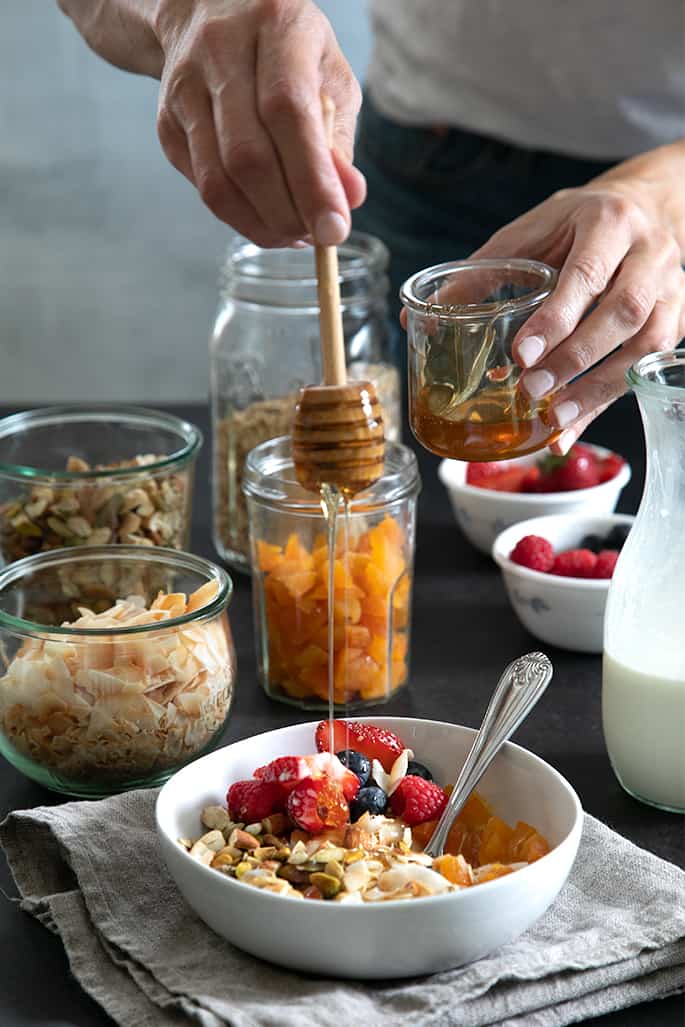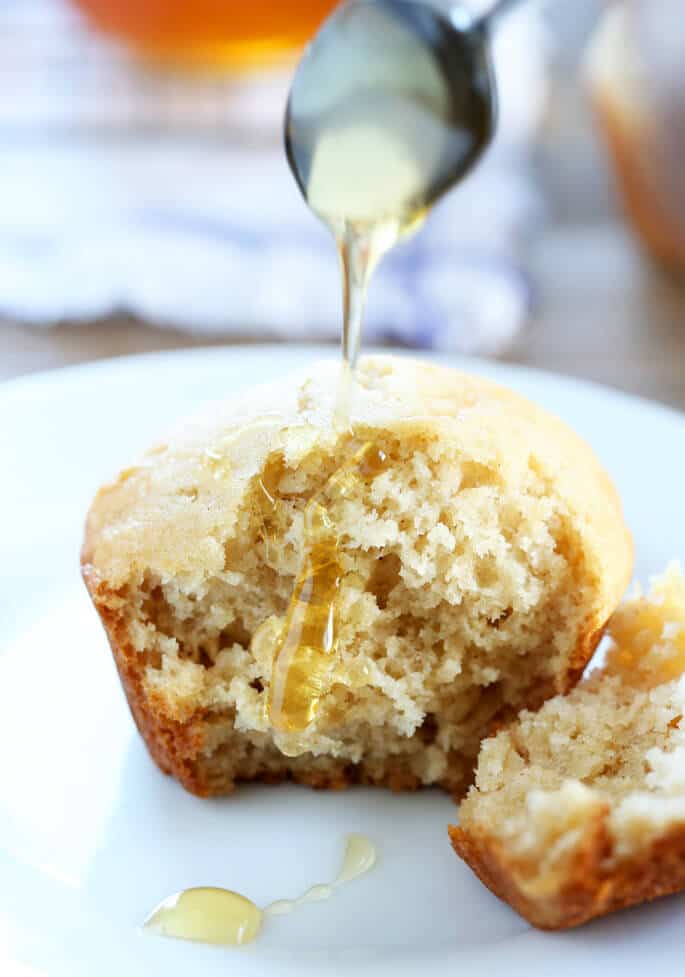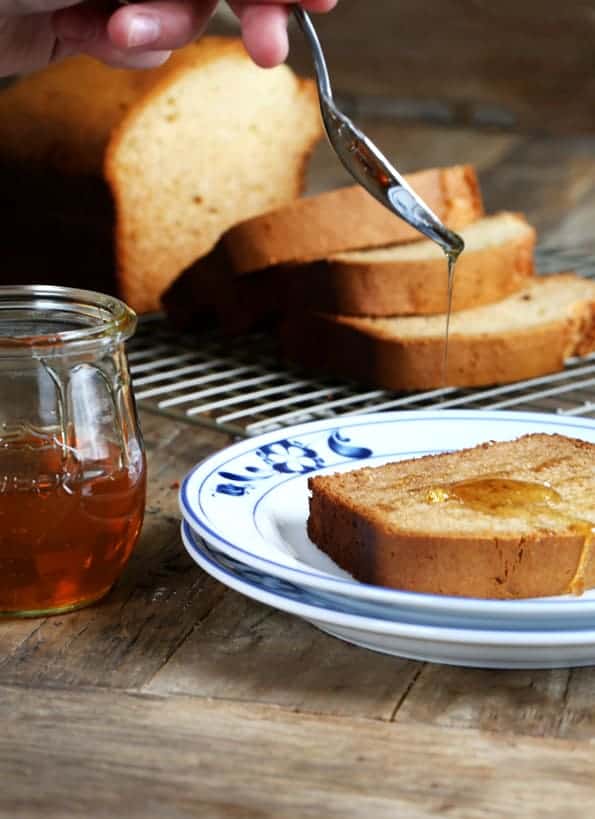Is honey gluten free? Yes, honey is naturally gluten free. And, theoretically, it's safe to eat on a gluten free diet. But there's more to it than simply grabbing some honey off the shelf.
Explore when honey is gluten free and when there's a risk of gluten cross contamination. Get the lowdown on which brands of honey are gluten free, gluten free honey recipes, and more.

WANT TO SAVE THIS RECIPE?
In a nutshell: Is honey gluten free?
As mentioned above, in theory, yes, honey is gluten free. But it depends heavily on where the honey comes from, what it's been mixed with, and how and where it's been processed once harvested from the hive.
Generally, raw honey isn’t contaminated with gluten, so it's safe for those with gluten intolerance. However, some brands of honey may contain added ingredients such as barley malt extract or wheat syrup that contain gluten and render it unsafe if you're on a gluten free diet.
It’s vital you read ingredient labels carefully when shopping for food products, even something as seemingly innocuous as honey. As well as intentionally added ingredients, honey can have some hidden or accidental gluten contamination from the processing facility, unless it's a dedicated gluten free site.
If you have celiac disease or are extremely sensitive to cross-contamination with gluten, it's safest to buy only honey certified gluten free.
What is honey?
Honey is made from the nectar of flowers. Honey bees (specifically the forager bees) collect the nectar from flowers in their honey stomachs, where the enzymes in the honey stomach start to convert the complex sugars into simple ones, and store it in their honeycombs.
Once the stomach is full, the forager bee returns to the hive and regurgitates the honey where house bees take over, continuing the conversion and removing as much moisture as possible. At this point, they deposit the processed honey into a honeycomb cell.
Then the bees beat their wings, fanning the honey to extract any remaining moisture. As the water evaporates, the nectar becomes more concentrated and eventually turns into honey. Then, the honeycomb cell is sealed with wax.
Is honey good for you?
Yes, in moderation, honey is good for you. Or, if you have a gluten sensitivity, gluten free honey is good for you. Just remember that it contains a lot of calories – around 64 calories in every tablespoon.
But yes, this natural sweetener has numerous health benefits. It's been used in wound care, wound healing, and burn healing. And numerous studies show it has antidepressant and anticonvulsant properties.
Since honey is packed with polyphenols and antioxidants, it can help reduce your risk of type 2 diabetes, metabolic syndrome, and heart disease. You can even put honey on a blemish to take advantage of its antimicrobial properties!
Is flavored honey safe on a gluten free diet?
Flavored honey can be problematic on a gluten free diet. Check the label for gluten-containing grains. Unless it's absolutely essential, you're likely better off flavoring your honey yourself as and when you need to.
Aside from flavored honey, honey-based and honey flavored products often include gluten containing foods. These can be salad dressings, honey mustard, or honey-flavored breakfast cereals.
Always check the label for gluten-containing ingredients. And only buy products labeled gluten free if you want to be certain of your safety.
The risk of honey cross contamination
Cross contamination with gluten is a major concern if you have gluten intolerance. Choose products that are certified gluten-free to guarantee that the honey is free from cross contamination.
Take the same precautions when handling and preparing the honey dish as you would with any other gluten-free food on a gluten free diet: this means using clean utensils and containers that have not been previously used with gluten containing foods.
By taking these extra steps, you can enjoy your favorite honey products without having to worry about any potential cross contamination.
Honey and honey products are at risk from cross contact mostly during production and manufacturing. If they're not produced in a dedicated gluten free facility or at least on a gluten free production line, there's a chance gluten particles could be present, so the end product could contain gluten.
If you need to avoid gluten, it's important to note that, while local, unfiltered honey is naturally gluten free, local beekeepers could be processing their honey in their home, where they may also use products that contain gluten, which can lead to gluten particles in their honey.
Brands of honey that are gluten free
If you're on a gluten free diet and want to enjoy honey safely, always check the label for gluten free certification.
At the time of writing, the following brands are good options. But this could change at any time, so always check before you purchase.
- Nature's Nate (certified gluten free)
- Comvita (certified gluten free)
- Greenbow Organic Honey (labeled gluten free)
- Beekeeper's Naturals (stated gluten free on website)
- Sioux Honey (stated gluten free on website)
- Bee Harmony (stated on website that there are no gluten ingredients and no gluten processed or stored in facility)
Honey Recipes
Natural honey is a great substitute for processed sugar in gluten free recipes. And it's an amazing flavor when it's the star of the show, too.
Whether you love raw honey drizzled on your favorite bread or over fruit and yogurt, or you want to enjoy the deep, rich honey flavor in your baked goods, go for it! Choose from one of the gluten free brands of honey and enjoy.
And I've included a few of my favorite honey recipes here to help you on your honey journey:

Grandma's gluten free honey muffins
Grandma's honey muffins are a delicious and easy way to enjoy a gluten-free treat. The honey adds a unique sweetness that enhances the flavor of the muffins.
They're light and fluffy, and you only need one bowl to make them. Enjoy the sweet muffins for breakfast or as an anytime snack.

Gluten free honey bread
This bread is the perfect way to bring the delicious flavor of honey into your gluten free diet. It's a light and fluffy quickbread that's packed with plenty of flavor.
Use a light honey or get a richer hit with a darker honey. Serve it with a pat of butter, extra honey, or just warm on its own.
FAQs
Does Manuka honey have gluten in it?
No. Manuka honey is gluten free. Since it is made from nectar collected from the Manuka tree's flowers, it does not contain wheat, barley or any other source of gluten in its natural form. However, it may be contaminated during processing, so check the label for the correct certification.
Is clover honey gluten free?
Yes, clover honey is generally considered gluten free. Since it is free from any flour or grains, it should be safe for people following a gluten-free diet. But, as always, only choose a honey that's labeled gluten free.
Are Honey Nut Cheerios gluten free?
No, Honey Nut Cheerios are not gluten-free. The product contains wheat and barley, which are both gluten containing ingredients. Therefore, people following a gluten-free diet should avoid eating Honey Nut Cheerios.

Thanks for stopping by!
Hi, I’m Nicole. I create gluten free recipes that really work and taste as good as you remember. No more making separate meals when someone is GF, or buying packaged foods that aren’t good enough to justify the price. At Gluten Free on a Shoestring, “good, for gluten free” just isn’t good enough! Come visit my bio!

Lois B says
what can I substitute for honey in the French Bread recipe?
Nicole Hunn says
Since there is only 1 tablespoon of honey, you can try replacing it with agave syrup or light corn syrup, which have a similar consistency. You can also try pure maple syrup, but it’s thinner so the dough will be a bit more wet.